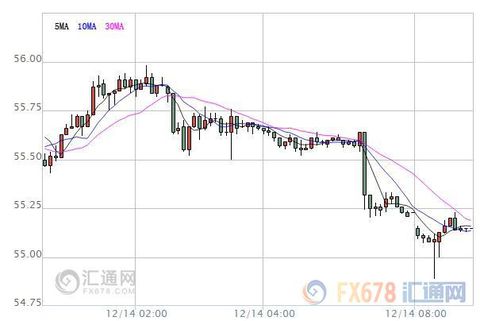-- On Wednesday (December 14), crude oil was at the beginning of the session, oil prices were under pressure, and US oil fell more than 1%. US oil traded at around 52.36 US dollars / barrel, a decline of about 1.17%; oil oil trading at 55.15 US dollars / barrel, a decline of about 0.29%. Although OPEC's agreement with non-OPEC to reduce production boosted market confidence, oil prices have remained relatively high in the near term. However, the latest monthly report of the International Energy Agency (IEA) shows that global crude oil supply reached a new high in November. At the same time, data released by the American Petroleum Institute (API) showed that the US crude oil inventories and gasoline inventories recorded an unexpected surge in last week, putting oil prices under pressure. The upcoming OPEC monthly report and the US EIA inventory report will provide guidance for the oil price outlook.

On Tuesday (December 13), oil prices closed up slightly. The US WTI crude oil January futures price hit a high of 53.41 US dollars per barrel. US WTI crude oil January futures closed up 0.28% to $52.98 per barrel; Brent crude February futures closed up 0.05% at $55.72 per barrel. Although OPEC reached a production reduction agreement to maintain oil prices at a relatively high level, while the continued decline in China's crude oil production also effectively boosted bullish confidence, the International Energy Agency (IEA) said that global crude oil supply reached a new high in November, OPEC increased production offset the non-OPEC The country's production cuts. Moreover, the US crude oil inventories and gasoline inventories recorded an unexpected increase in last week, limiting the upside of oil prices.

(The picture above shows the K-line chart of the January contract price of US NYMEX crude oil futures)

(The picture above shows the B-line chart of the Brent crude oil futures contract price)
According to Huitong.com, a non-OPEC oil-producing country headed by Russia reached a production reduction agreement at the Vienna meeting on Saturday (December 10), agreeing to cut production by 558,000 barrels per day. Although this figure is slightly below the target of 600,000 barrels per day, it is still the largest reduction in production in non-OPEC oil producing countries. Earlier, OPEC had reached a production reduction agreement on November 30, and promised to reduce production by 1.2 million barrels per day from January 1 next year. Saudi Arabia, OPEC's largest crude oil exporter, will cut production by about 486,000 barrels per day to alleviate the global crude oil supply surplus in the oil market in the past two years.
OPEC Secretary General Balkindu said on Tuesday (December 13) that the agreement on production cuts in Vienna dispelled doubts about the role of the OPEC market. Global oil demand is expected to increase by 17 million barrels per day by 2040. OPEC has tried to cut production to meet the growth rate. Therefore, there is full confidence in the OPEC production reduction agreement to stabilize the market.
Brown Brothers Harriman Bank (BBH) research team said that although OPEC and non-OPEC oil producers reached a production reduction agreement, but because there is no relevant mechanism, the real challenge is whether the production cuts can be put in place. However, it is still too early to worry about the occurrence of violations of production reduction agreements by oil-producing countries. The future is optimistic, and the above positives will further push up oil prices. In the coming months, US oil is expected to rise to $57-65/barrel.
Finance Network, station MarketWatch said on Tuesday (December 13) that the success of the agreement to reverse the long-term oversupply depends on seven factors: whether the oil-producing country complies with the commitment to reduce production, whether Saudi Arabia increases idle capacity, and reduces production. Is it just a "digital game", a high starting point due to record highs, a decline in global demand for crude oil, a sharp increase in US shale oil production, and an increase in production in Nigeria, Libya and Iran.
From the perspective of supply and demand fundamentals, data released by the American Petroleum Institute (API) on Wednesday (December 14) at 05:30 shows that as of December 9th, US API crude oil inventories unexpectedly increased by 4.68 million barrels. The decline was 1.467 million barrels. Gasoline inventories increased by 3.9 million barrels, which is expected to increase by 2.6 million barrels; refined oil inventories rose by 233,000 barrels, which is expected to decrease by 167,000 barrels; Cushing crude oil inventories increased by 632,000 barrels, which is expected to increase by 4 million barrels.
The well-known financial zero-hedging reported that the US crude oil inventories recorded a sharp increase in the week of December 9th, and gasoline inventories also recorded the largest increase since January. However, after the substantial increase in crude oil inventories in the Cushing area in the previous two weeks, this week's increase was less than expected.
The monthly report on the crude oil market released by the International Energy Agency (IEA) on Tuesday (December 13) in Beijing showed that global crude oil supply hit a record level of 98.2 million barrels per day in November. The increase in OPEC offsets the reduction in production in non-OPEC countries. If OPEC and non-OPEC countries comply with the production reduction agreement, the oil market will have a shortage of 600,000 barrels per day in the first half of next year. OPEC production is expected to increase by 300,000 barrels per day to 33.6 million barrels per day in 2017. The non-OPEC countries' oil supply growth in 2017 will be lowered by 255,000 barrels per day. It is expected that the non-OPEC countries' oil supply will increase by 200,000 barrels per day to 57 million barrels per day in 2017. In addition, the IEA monthly report also raised the forecast for global crude oil demand growth this year and next. The global demand for crude oil in 2017 will be raised to 97.6 million barrels per day due to higher demand in China and the United States. It also raised its forecast for China's crude oil demand in 2016 by 135,000 barrels per day to 11.9 million barrels per day.
The US Department of Energy announced that after being authorized by the US Congress last week, it will begin selling some strategic reserve crude oil as early as January next year. The first batch will sell $375.4 million for operational and improvement funding, estimated at approximately $7 million for the $53/barrel oil price. At present, the United States strategic reserves of crude oil totaled 695 million barrels. In addition, Congress has authorized its sale of 10 million barrels in fiscal 2017.
According to FX678, data released by the National Bureau of Statistics on Tuesday (December 13) showed that refinery refinery volume in November increased by 3.4% year-on-year to a record high of 45.77 million tons, mainly due to the gradual completion of refinery repairs and independent refineries. Increase output. At the same time, PetroChina's 601,857, stock output declines, because oil producers continue to maintain production measures for inefficient oil fields.
Huitong.com reminds: The US Energy Information Administration (EIA) will release the US EIA crude oil inventory report for the week ending December 9 at 23:30 Beijing time on Wednesday. Investors should pay close attention. In addition, investors should also pay attention to the OPEC monthly crude oil market report to be announced on Wednesday, Beijing time (usually announced around 18:00-20:00 Beijing time).
From the perspective of market linkage, at 03:00 Beijing time on Thursday (December 15), the Fed will announce the latest interest rate resolution and Federal Reserve Chairman Janet Yellen will hold a press conference later. The market generally expects the Fed to raise interest rates by 25 basis points, while the current market is particularly concerned about whether the dovish raises interest rates or the hawks raise interest rates. The US dollar index was basically steady in cautiousness on Tuesday (December 13). Under normal circumstances, a stronger dollar will weigh on the dollar-denominated oil price. The weaker dollar has supported oil prices to a certain extent. Investors need to pay close attention to the trend of the US dollar index.
In terms of geography, the Trump transition team said on Tuesday (December 13) that Tillerson was nominated as the US Secretary of State, saying that he hoped that Tillerson could bring geopolitical experience. Barking expressed his congratulations to Tillerson, who is a strong advocate of oil stability and said that the line between oil, geopolitics and diplomacy is very vague.
In anticipation of the market, the International Energy Agency (IEA) Director Birol said that global demand for crude oil will be weak as prices rise. If both OPEC and non-OPEC countries can cut production, the market will rebalance in the first half of next year. China’s current oil production is declining due to low oil prices, but now OPEC has reached a global agreement to reduce production. If the price of oil rises to US$60/barrel, oil extraction will be profitable, which will prompt China and the United States. The oil production of the land has recovered.
Well-known oil hedge fund manager Pierre Andurand believes that crude oil prices will hit $70/barrel in June 2017. He pointed out that the joint production cut by OPEC and non-OPEC oil producers will bring the crude oil market back to balance, and the Vienna conference will become a key turning point for oil prices.
US macro policy research firm SGH said that oil-producing countries' production cuts are aimed at stabilizing oil prices rather than pushing them up. They hope that the oil price will stabilize at 50-60 US dollars/barrel in the first half of 2017. It is expected that supply and demand will be balanced again. However, if the oil price rises too fast or is much higher than 60 US dollars/barrel, Saudi Arabia will take the lead to introduce more supplies to the market.
Huitong Finance Yihuitong market software shows that at 09:52 Beijing time, WTI crude oil reported 52.36 US dollars / barrel; Brent crude oil reported 55.13 US dollars / barrel.
(Editor: HN666)
Men'S Socks,Men'S Cotton Socks,Men'S Mid-Tube Socks,Men'S Sports Socks
Jingjiang Pingdong Import&Export Co.,Ltd , https://www.jingjiangsocks.com
![<?echo $_SERVER['SERVER_NAME'];?>](/template/twentyseventeen/skin/images/header.jpg)